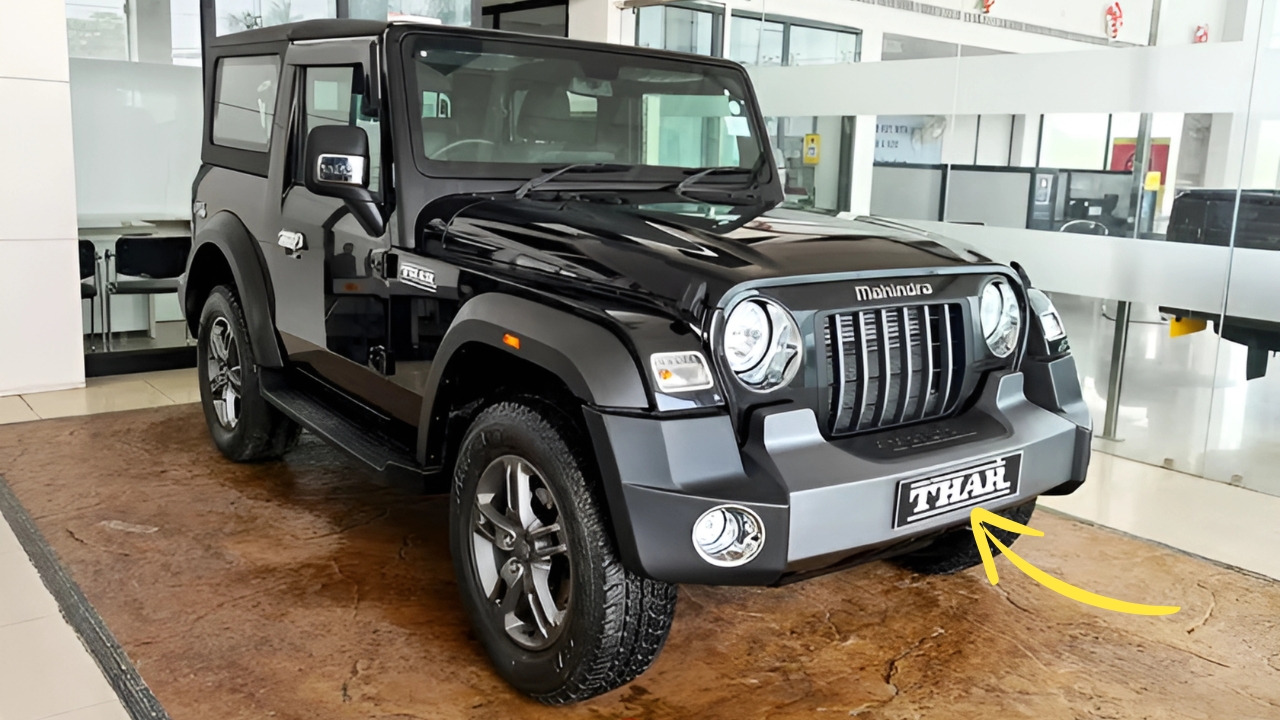Mahindra Thar: The Mahindra Thar represents one of India’s most distinctive automotive success stories, combining rugged capability with cultural significance that transcends typical vehicle ownership.
Since its introduction in 2010 and through its comprehensive second-generation redesign in 2020, the Thar has evolved from a utilitarian off-road specialist to a lifestyle vehicle with broad appeal while maintaining its fundamental character.
This journey illustrates the changing Indian automotive market and Mahindra’s growing engineering sophistication.
Mahindra Thar: Design Heritage and Evolution
The Thar’s design draws unmistakable inspiration from iconic off-road vehicles, particularly the Jeep CJ series that Mahindra manufactured under license decades earlier.
This heritage provides immediate visual recognition through characteristic elements including the seven-slot grille, circular headlamps, flared wheel arches, and boxy silhouette.
While these references created some international trademark controversies, they connect the vehicle to a rich off-road legacy immediately understood by enthusiasts.
The second-generation model introduced in 2020 retained these core design elements while introducing significant refinements.
The dimensions increased to 3,985mm length, 1,855mm width, and 1,920mm height, creating more substantial road presence while improving interior space.
The wider track (1,565mm front/1,592mm rear) enhances stability, while 226mm ground clearance and approach/departure angles of 41.8° and 36.8° respectively ensure genuine off-road capability.
Available in both fixed hardtop and convertible configurations, the Thar provides flexibility uncommon in the Indian market.
The convertible option features a manually removable roof section with innovative weather sealing that addresses monsoon conditions common across the subcontinent. The side-hinged rear door maintains visual continuity with off-road traditions while providing practical access to the cargo area.
Engineering and Off-Road Capabilities
The second-generation Thar represents a significant engineering advancement over its predecessor, transitioning from a dedicated off-road platform to a more sophisticated foundation balancing all-terrain capability with everyday usability.
The ladder-frame construction maintains traditional off-road strength while incorporating modern crash structures and noise isolation techniques.
The four-wheel-drive system features a two-speed transfer case with shift-on-fly capability, allowing transition between 2H, 4H, and 4L modes according to terrain requirements.
The mechanical locking rear differential enhances traction in challenging conditions, while the brake-locking differential function on the front axle provides additional capability through electronic intervention when needed.
Suspension architecture employs independent double wishbones at the front and a multi-link rigid axle at the rear—a configuration that balances articulation capabilities with improved on-road dynamics compared to the previous generation’s double solid axle arrangement.
The coil spring implementation at all four corners delivers superior ride quality while maintaining necessary wheel travel for obstacle navigation.
Water fording capacity of 650mm addresses practical requirements for monsoon season and off-road excursions, while the structural protection for vital components ensures durability during challenging terrain navigation.
These capabilities deliver genuine off-road performance that exceeds typical “soft-roader” alternatives focused primarily on styling rather than capability.
Powertrain Options and Performance
The Thar offers two distinctive powertrain options reflecting different priorities. The 2.0-liter mStallion turbocharged petrol engine produces 150 horsepower and 320 Nm of torque, delivering responsive performance particularly valuable for urban and highway driving.
This relatively sophisticated direct-injection unit provides reasonable efficiency despite the vehicle’s aerodynamic limitations.
The 2.2-liter mHawk diesel engine generates 130 horsepower and 300 Nm of torque, emphasizing low-end torque delivery particularly beneficial during off-road maneuvers requiring precise power application.
This diesel option particularly appeals to buyers prioritizing long-distance touring efficiency and traditional off-road characteristics.
Both engines offer six-speed manual or automatic transmission options, providing flexibility across different usage patterns and driver preferences.
The automatic variant includes cruise control functionality, enhancing long-distance touring comfort.
While not delivering sports car acceleration, the performance proves entirely adequate for the vehicle’s intended purposes, with respectable highway cruising capability despite the upright aerodynamic profile.
Interior Refinement and Technology
The second-generation Thar’s interior represents perhaps the most dramatic evolution from its predecessor, transitioning from utilitarian simplicity to reasonably sophisticated comfort without abandoning the vehicle’s fundamental character.
The dashboard design maintains a practical upright layout with water-resistant materials that acknowledge the vehicle’s off-road intentions.
The front seating position provides commanding visibility beneficial for both off-road obstacle navigation and urban traffic situations.
The second row accommodates two passengers with reasonable comfort—a configuration that prioritizes individual space over maximum capacity.
Forward-facing rear seats replace the sideways bench arrangement of the previous generation, significantly enhancing safety and comfort.
Technology integration includes a 7-inch touchscreen infotainment system featuring smartphone connectivity, navigation functionality, and an off-road information display showing vehicle tilt, compass direction, and drivetrain status.
The instrument cluster combines analog gauges with a digital multi-information display providing essential vehicle data.
Safety features represent substantial advancement, with dual front airbags, ABS, electronic stability control, hill-hold and hill-descent control, and a roll cage structure providing protection during extreme off-road situations or unlikely rollover scenarios.
These features address modern expectations while maintaining the vehicle’s adventure-oriented positioning.
Cultural Impact and Ownership Experience
The Thar transcends conventional vehicle ownership through strong cultural associations with adventure, independence, and distinctly Indian resilience.
Ownership frequently extends beyond practical transportation to lifestyle identification, with robust owner communities organizing group expeditions and modification showcases across the country.
This cultural significance manifests in exceptional resale value retention, with used examples frequently commanding prices approaching new vehicle cost—a rarity in the Indian market where depreciation typically occurs more rapidly.
The customization ecosystem has expanded significantly, with numerous aftermarket suppliers offering everything from practical capability enhancements to purely aesthetic modifications.
The ownership experience balances genuine capability with reasonable everyday practicality, though with compromises inherent to the vehicle’s fundamental design.
Wind noise at highway speeds, limited cargo capacity, and fuel efficiency reflecting the aerodynamic profile represent acknowledged trade-offs for the vehicle’s character and capability.
Mahindra Thar:
The Mahindra Thar represents a distinctive success story in the Indian automotive landscape, maintaining authentic character while evolving to meet contemporary expectations.
By balancing genuine off-road capability with improved refinement and safety, Mahindra has expanded the vehicle’s appeal beyond enthusiast circles while maintaining the fundamental identity that established its cultural significance.
The Thar’s journey from specialized tool to lifestyle icon parallels broader changes in the Indian automotive market, where increasing sophistication and personal expression have become important purchase considerations alongside practical functionality.
As the market continues evolving toward electrification and enhanced connectivity, the Thar’s distinctive character positions it favorably for continued relevance through thoughtful adaptation rather than fundamental reinvention.
Also read this –

